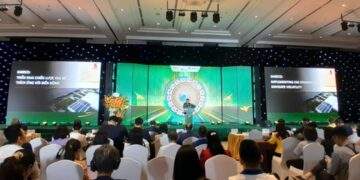The project is set to cost VND76 trillion (US$2.93 billion) with 15% coming from its capital and 85% from loans, the company said in a conference on green transportation Friday in HCMC.
Land clearance, costing over VND7.6 trillion ($288 million), is set to be covered by the state’s coffers.
The proposed speed triples that of the operating Ben Thanh – Suoi Tien metro.
VinSpeed CEO Nguyen Anh Tuan said that choosing a highspeed option right from the start is easier than upgrading post-construction. Actual operational speed can be lower depending on needs, he added.
 |
|
A road in Can Gio area, Ho Chi Minh City, September 2024. Photo by VnExpress/Quynh Tran |
The company plans to begin construction in the last quarter this year and complete it early 2028.
“This is a challenging timeline, considered a record for a metro line, but we are confident in meeting the schedule,” he said.
Given Vietnam’s lack of experience with such projects, VinSpeed has studied international models and conducted geological and topographical surveys along the route before making the proposal, he added.
Experts at the seminar praised the proposal’s ambition, noting it could redefine metro and railway development in Vietnam.
However, they highlighted challenges in technical standards, technology, and operations, urging careful evaluation of multiple options.
Truong Tien Trien, deputy head of HCMC’s Urban Development Management Board, said the metro would transform connectivity to Can Gio, currently accessible only by ferries.
He raised concerns about the 350 kph speed, suggesting it might hinder passengers’ ability to “enjoy Can Gio’s unique natural scenery.”
Tran Du Lich, head of HCMC’s metro network development advisory group, emphasized the necessity of the Can Gio metro but stressed environmental protection.
“The route, even if curved, must avoid impacting the Can Gio International Biosphere Reserve,” he said.
Phan Huu Duy Quoc, chairman of Construction Corporation No. 1, which took part in the construction of the Ben Thanh – Suoi Tien metro, recommended optimizing service roads and construction sites to reduce environmental impact.
For the river-crossing section, he suggested an underground tunnel as an alternative to building a new bridge.
“Tunneling under rivers or urban areas is similar, and we have experience from the Ben Thanh – Suoi Tien line.”
Can Gio, located about 50 km from central HCMC, spans over 71,300 hectares, with 70% covered by mangrove forests and waterways.
HCMC’s metro network plan includes 11 lines, with seven (355 km) targeted for completion by 2035.
Metro Line 2 (Ben Thanh – Tham Luong) is set to start construction later this year, paving the way for additional lines from 2027.





